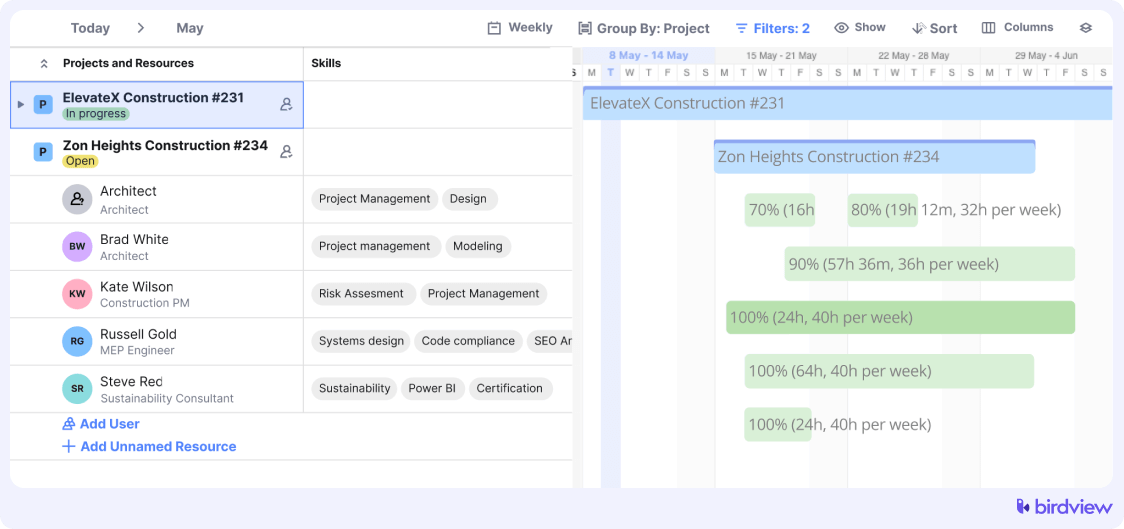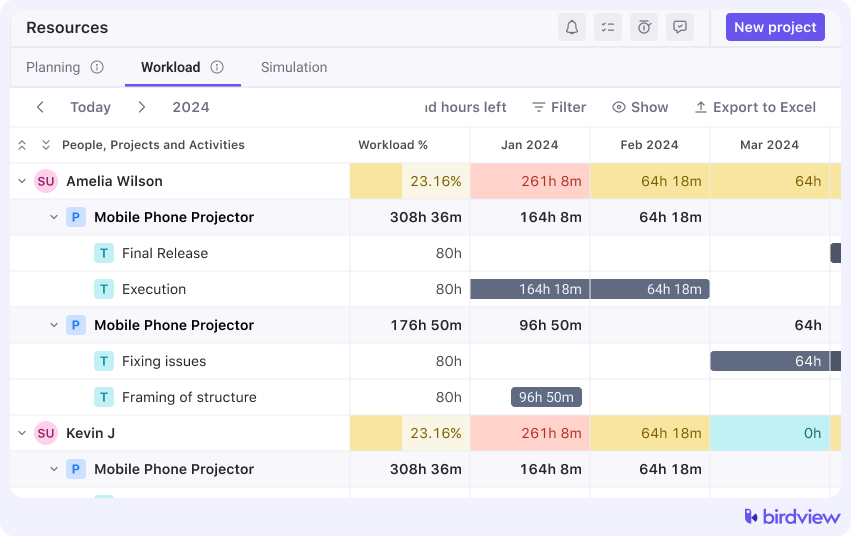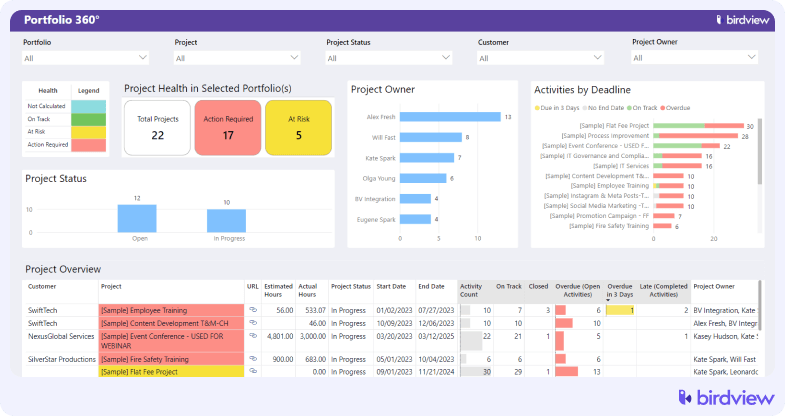Juggling multiple projects with a limited pool of talent is one of the toughest challenges for any service organization. You‘ve likely seen the consequences: your best people are overbooked and heading for burnout, critical deadlines are missed, and project profitability suffers. When resource conflicts become the norm, it feels like you‘re constantly fighting fires instead of driving strategic growth.
This article provides a tactical playbook to move beyond reactive problem-solving. You’ll learn how to not only resolve resource conflicts in project timelines but also how to proactively prioritize projects for resource allocation using a clear, repeatable framework. With a unified system providing a single source of truth, you can turn operational chaos into predictable, profitable delivery.
Why resource conflicts happen (and why spreadsheets aren’t the answer)
Resource conflicts arise from poor visibility into team capacity, siloed project planning, and unexpected changes in project scope or priority. Spreadsheets and other disconnected tools fail because they are manual, static, and disconnected from real-time project data, making it impossible to adapt quickly to changing demands.
You can’t solve a problem you can’t see, and without a centralized view, you‘re essentially managing resources with blinders on. The result is a constant struggle to keep projects on track and resources balanced.
Lack of real-time capacity visibility
The most common cause of resource conflicts is a simple lack of visibility. When a project manager needs to staff a new project, they often make assignments based on gut feelings or outdated information. They don’t have a clear, immediate view of who is available, who is already at 100% capacity working on other projects, and who has upcoming PTO. This inevitably leads to overbooking your most skilled team members.
📚 Read more: Capacity forecasting: how do you forecast your team‘s capacity?
Disconnected project and resource planning
In many organizations, project planning and resource planning happen in separate systems–or even separate departments. A project manager might build a perfect timeline in one tool, while a resource manager assigns teams from a spreadsheet. This disconnect means resource needs aren’t considered until after deadlines have been set, forcing last-minute scrambles and compromises that put project success at risk.
Shifting priorities and scope creep
Your plans are only as good as their ability to adapt to change. A high-priority client may have an urgent request, or a new, lucrative project may appear unexpectedly. Without a system to evaluate the impact of these changes, managers are forced to pull resources from existing projects, creating a domino effect of delays and conflicts across the entire portfolio.
📚 Read more: How to handle scope changes in client projects
The failure of static tools
Spreadsheets are the default tool for many, but they are fundamentally unsuited for dynamic resource management. They can‘t automatically update when a project timeline shifts, they don‘t provide a visual representation of workloads over time, and they offer no “what-if” scenario planning. Trying to manage resource conflicts with static data is like trying to navigate a busy highway using a printed map–by the time you look at it, the reality has already changed. These are some of the most common resource allocation problems that a unified platform is built to solve.
A 4-step framework to manage resource conflicts
To effectively manage resource conflicts, you need a four-step framework: 1) Centralize visibility to see all projects and resources in one place, 2) Establish a clear project prioritization model, 3) Implement standardized conflict resolution tactics, and 4) Leverage a Professional Services Automation (PSA) tool for dynamic scheduling and forecasting.
This framework provides a structured approach to transform resource management from a reactive, chaotic process into a proactive, strategic function that drives business value.
Step 1: Gain a single source of truth for visibility
The first and most critical step is to consolidate all project and resource information into a single platform. When your entire team works from one system, you gain a real-time, bird’s-eye view of your entire operation–every project, every task, every resource, and every timeline.
This is the core benefit of Professional Services Automation (PSA) software. A platform like Birdview PSA centralizes data to eliminate blind spots, showing you exactly who is working on what and when they will be available next. This unified view is the foundation upon which all other conflict resolution strategies are built.

Step 2: Define your project prioritization rules
Not all projects are created equal. When resources are scarce, you need a clear and objective method for deciding which projects get staffed first. Create a simple scoring model or a set of rules based on factors that matter most to your business. This removes ambiguity and ensures that resource decisions align with strategic goals. Common criteria include project profitability, client value, and strategic importance.
Step 3: Apply tactical conflict resolution strategies
Once you have visibility and a prioritization framework, you can apply specific tactics to resolve conflicts as they arise. The right strategy will depend on the project’s flexibility and the nature of the resource constraint.
- Resource Leveling: This technique involves delaying non-critical tasks or even entire projects until the assigned resource becomes available. It may extend the project timeline but keeps the resource’s workload manageable.
- Resource Smoothing: If a project has slack or “float” time in its schedule, you can adjust task start and end dates within that window to smooth out a resource’s workload peaks without delaying the final deadline.
- Resource Substitution: When a specific resource is over-allocated, check if another team member with the required skills is available. A skills matrix within your PSA tool makes it easy to identify qualified substitutes.
- Negotiation: Sometimes, the best solution is to communicate. Talk to stakeholders to see if you can adjust the project timeline, reduce the scope, or break deliverables into smaller phases.
Step 4: Use software for dynamic resource allocation
Manual adjustments are time-consuming and prone to error. Modern resource planning software automates much of this process. With Birdview PSA, you can use interactive, drag-and-drop workload views to see the impact of schedule changes in real time. The system can automatically flag over-allocations and help you balance workloads across teams, ensuring you make the most of your available capacity.

How to prioritize projects for resource allocation
To prioritize projects for resource allocation effectively, you must create a scoring model based on business-driven criteria such as financial impact, strategic alignment, client importance, and risk. This data-driven approach ensures that your most valuable projects always get the resources they need to succeed, maximizing your organization’s return on investment.
Prioritize by project profitability
Your most profitable projects should be your top priority. By integrating project financials with resource management, you can easily identify high-margin work and ensure it receives the necessary attention and talent. This direct link between operations and finance is crucial for sustainable growth.
📍 Example: Birdview PSA allows you to track budgets, costs, and billable hours for every project, giving you a real-time view of profitability. When a resource conflict occurs, you can run a report to see which of the competing projects has a higher profit margin and align resource management with budgeting to make a data-backed decision.
Prioritize by client value or tier
All clients are important, but some are more strategic to your business than others. You can create a tiering system (e.g., Platinum, Gold, Silver) based on contract size, long-term partnership potential, or strategic importance. When a conflict arises, projects for top-tier clients get priority, helping you nurture your most valuable relationships.
📍 Example: In Birdview PSA, you can use custom fields to tag projects by client tier. When scheduling resources, you can filter the project list to focus on “Platinum” clients first, ensuring their needs are met before allocating remaining capacity to other projects.
Prioritize by strategic alignment
Every project should contribute to your organization’s broader business goals. By categorizing projects based on the strategic objectives they support (e.g., “Market Expansion,” “Product Innovation,” “Operational Efficiency”), you can ensure that your limited resources are always working on what matters most.
📍 Example: Birdview PSA’s portfolio management capabilities allow you to group projects by strategic initiative. With BI reports that improve portfolio decision-making, executives can see if resource allocation matches the company’s strategic priorities and make adjustments as needed.

Key metrics to track for improved resource utilization
To improve resource utilization and make smarter scheduling decisions, you must consistently track key performance indicators (KPIs). The most important metrics to monitor are Resource Utilization Rate, Capacity vs. Demand, Planned vs. Actual Hours, and Project Profitability. These metrics provide the data you need to move from guesswork to data-driven resource management.
- Resource Utilization Rate: This is the percentage of a resource’s available time that is spent on billable or productive work. Tracking this helps you ensure your team is operating efficiently without being overworked. A healthy target is often around 80%, leaving room for administrative tasks and professional development.
- Capacity vs. Demand: This metric compares your team’s total available work hours (capacity) against the total hours required for all planned projects (demand). Forecasting this helps you identify future resource shortages or surpluses, allowing you to hire or retrain staff proactively.
- Planned vs. Actual Hours: Comparing the time you estimated for a task or project against the actual time it took is crucial for improving future planning. If a project consistently requires more hours than planned, it signals a need to refine your estimation process or investigate underlying issues.
- Project Profitability: Ultimately, effective resource allocation should drive financial success. By tracking profitability at the project and client level, you can identify which types of work are most lucrative and focus your resources accordingly. Monitoring KPIs for service firms is simplified with integrated reporting tools.
With Birdview PSA‘s Business Intelligence Dashboards, all of this data is collected automatically and presented in easy-to-read visual reports. You can create role-specific dashboards for project managers, executives, and finance teams, giving everyone the insights they need to make informed decisions without having to manually compile data from different sources.
Create an adaptable resource schedule with Birdview PSA
You can create an adaptable and resilient resource schedule by using a unified platform like Birdview PSA that offers real-time visibility, “what-if” scenario planning, and integrated project and resource management. This allows you to adjust schedules quickly as priorities change, without causing widespread disruption.
With a centralized platform for professional services, you can see everyone’s availability, skills, and current workload in one place. Instead of guessing who can take on a new task, you can make an informed choice based on real-time data.
Features like Birdview PSA‘s “what-if” scenarios are invaluable for agile planning. Before committing to a new project, you can model its impact on your current resource plan to see if you have the capacity. This allows you to accept new work with confidence, knowing you can deliver without overbooking your team. The tight integration between project timelines and resource schedules ensures that a change in one place is automatically reflected everywhere else, keeping everyone aligned.
Gain control over your projects and resources
Moving from reactive fire-fighting to proactive, strategic resource allocation is not just possible–it‘s essential for growth. By establishing a clear prioritization framework and leveraging a single source of truth, you can resolve conflicts before they derail your projects, align your team‘s efforts with your business goals, and drive predictable profitability.
When you have a clear view of your resources, projects, and finances, you can make confident decisions that lead to better outcomes: higher profit margins, happier clients, and a balanced, productive team.
Ready to take control? Try Birdview for free or Book a demo to see how a unified PSA platform can transform your resource management.
Frequently asked questions
What are the most effective strategies for managing resource conflicts in project timelines?
The most effective strategies include centralizing resource visibility with a PSA tool, establishing a clear project prioritization model, and using tactics like resource leveling, substitution, and negotiating timelines. A proactive approach is always better than a reactive one.
How can I create a resource schedule that adapts to changing project priorities?
Create an adaptive schedule by using a unified platform like Birdview PSA that offers real-time workload views and “what-if” scenario planning. This allows you to see the impact of priority shifts immediately and reallocate resources using drag-and-drop functionality, ensuring your schedule remains realistic and achievable.
Which key metrics should I track to improve resource utilization?
Key metrics include resource utilization rate (billable vs. non-billable), capacity vs. demand, planned vs. actual hours, and project profitability. Tracking these KPIs helps you make data-driven decisions to optimize workloads, improve forecasting, and maximize financial performance.
Further reading



